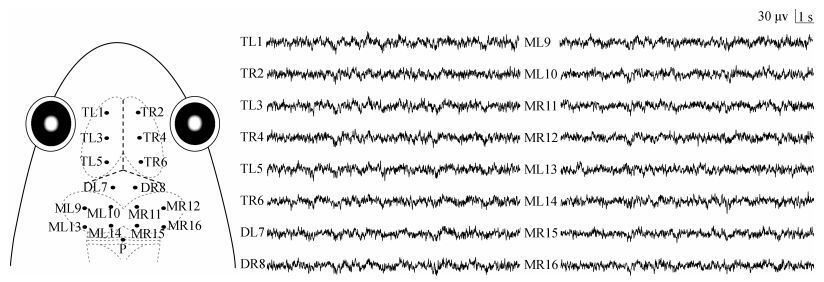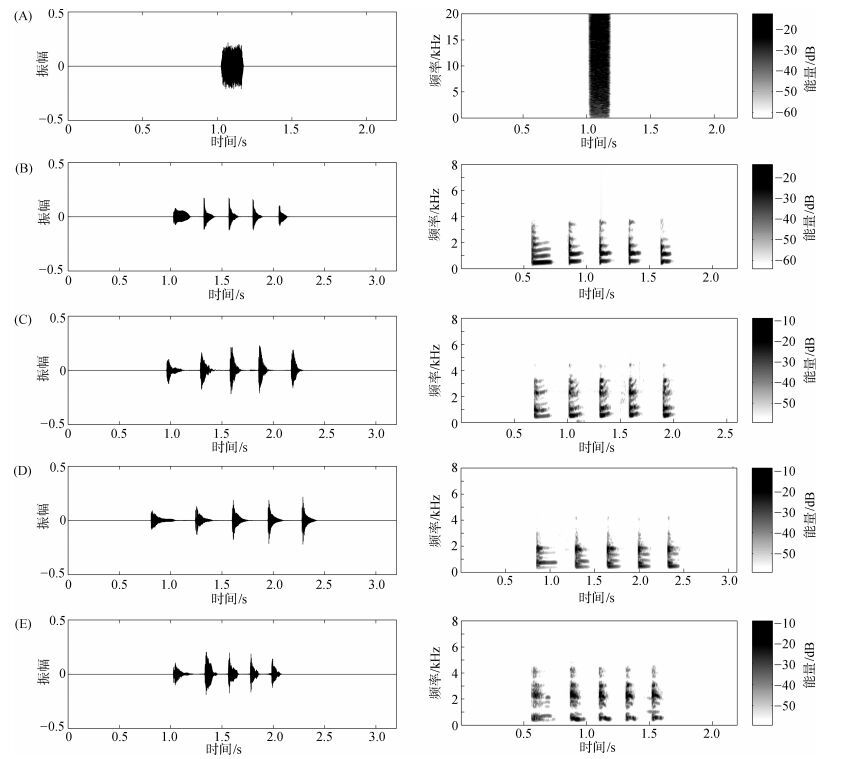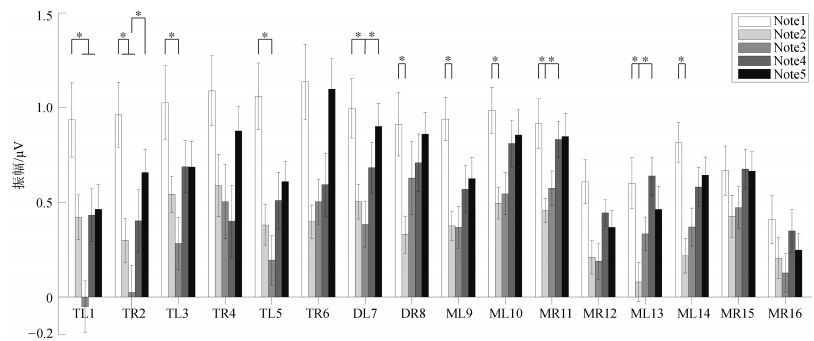扩展功能
文章信息
- 乐西子, 江帆, 薛飞, 方光战, 唐业忠
- YUE Xizi, JIANG Fan, XUE Fei, FANG Guangzhan, TANG Yezhong
- 仙琴蛙广告鸣叫中不同音节生物学意义的差异研究
- Biological Significances of Advertisement Call Notes in Babina daunchina
- 四川动物, 2017, 36(3): 241-248
- Sichuan Journal of Zoology, 2017, 36(3): 241-248
- 10.11984/j.issn.1000-7083.20160313
-
文章历史
- 收稿日期: 2016-11-14
- 接受日期: 2017-01-20
2. 中国科学院大学, 北京 100049
2. University of the Chinese Academy of Sciences, Beijing 100049, China
声音通讯是发声动物交流的重要手段之一。一般而言, 动物鸣声往往传递着物种、个体特征、繁殖状态、所处位置、资源占有等相关信息(Wells & Schwartz, 2007), 同时反映繁殖、领地防卫、觅食、反捕食等多种行为状态(Ryan, 1985;Magnhagen, 1991), 即动物鸣声包含极为复杂的信息(Brillet & Paillette, 1991;Doupe & Kuhl, 1999;Tang et al., 2001;Briefer et al., 2010;Suzuki et al., 2016), 但是鸣声在时域上各组成部分的功能及其在声音通讯中的重要程度(即生物学意义差异)尚无定论。由于鸣声各部分的时频特征具有明显差异, 动物对不同部分表现出不同的行为响应(Williams & Staples, 1992;Tang et al., 2001;Suzuki et al., 2016)。据此推测, 在声音通讯中, 鸣声各部分的功能及生物学意义不尽相同。
无尾两栖类的鸣声一般由音节(note)和间隔组成, 这为研究鸣声各部分的功能与生物学意义提供了便利。与其他多数蛙类相似, 仙琴蛙Babina daunchina的求偶行为多在夜间进行, 几乎完全依赖于声音通讯。雄性仙琴蛙一般在泥洞内鸣叫, 也会在洞外鸣叫, 雌雄两性均对前者的响应更大(Cui et al., 2012;Fang et al., 2014a)。雄性广告鸣叫包含一至十余个音节及持续时间约为150 ms的间隔;由于各音节均有明显不同的时频特征(Chen et al., 2011), 且第一个音节可能在声音识别和鸣叫类型识别中起重要作用(Fang et al., 2015), 所以仙琴蛙特别适合用于探究音节的生物学意义差异。
事件相关电位(event-related potential, ERP)是感觉运动或认知事件在大脑内诱发的、具有锁时关系的脑电(electroencephalogram, EEG)电位变化, 与认知过程(包括注意、辨别、判断、选择和决策等)密切相关, 其幅值和潜伏期可用于考察大脑对信息的加工过程、加工效率和时间进程(Luck, 2005)。特别地, 幅值往往表征着大脑在认知过程中所投入的资源。相关研究显示, 仙琴蛙EEG/ERP信号会对不同声音刺激表现出显著差异(Fang et al., 2014b, 2015;Xue et al., 2016)。据此推测, 音节的生物学意义差异可通过ERP幅度表现出来。
本研究采用优化的失匹配负波(mismatch negativity, MMN;一种ERP成分)实验范式, 在播放不同声音刺激的同时, 采集仙琴蛙的脑电信号;通过叠加平均获取MMN成分, 进行统计比较, 以此探讨各音节的生物学意义及听觉神经回路特性。预测不同音节诱发的MMN幅度存在差异, 而第一个音节对应的幅度最大。
1 实验材料和方法 1.1 实验对象与手术过程实验所用的16只成体仙琴蛙(雌雄各半)采自峨眉山, 按性别分开饲养于半透明箱中(45 cm× 35 cm×30 cm), 箱内有适量的泥和水。饲养箱置于12 h光照周期(08: 00开灯)和恒温(23 ℃±1 ℃)的饲养房中, 每3 d投喂活蟋蟀。手术时, 仙琴蛙平均体质量11.0 g±0.6 g, 平均体长4.6 cm±0.1 cm。实验在其繁殖期进行, 所有相关操作遵守中国科学院成都生物研究所关于动物福利的相关规定。
使用0.15%鱼安定(Metacaine, MS-222) 麻醉动物(Smith, 1974;Späth & Schweickert, 1977;Lalonde-Robert et al., 2012), 暴露颅骨顶部, 埋植电极, 16个电极分别位于端脑、间脑和中脑左右两侧, 参考电极在小脑上方。图 1显示端脑6个电极(TL1、TR2、TL3、TR4、TL5、TR6)、间脑2个电极(DL7、DR8)、中脑8个电极(ML9、ML10、MR11、MR12、ML13、ML14、MR15、MR16)、参考(P)及对应的20 s EEG特征波形。用牙托水泥将电极固定在颅骨上, 最后用局部消炎止痛药膏均匀涂抹创口。仙琴蛙清醒后单独置于装有适量纯净水的饲养盒中, 并在水中加入适量庆大霉素消炎, 恢复6 d后开始实验。实验结束后, 对仙琴蛙进行安乐死, 并在电极的相应位点注射苏木精染料, 检查电极位置是否与预期一致。

|
| 图 1 电极位置分布图及相应的20 s脑电特征波形 Fig. 1 Electrode placements and corresponding 20 s, typical electroencephalogram tracings 蛙脑中3条加粗虚线的交叉点表示人字缝;电极坐标: TL1(-1.5, 3.8), TR2(1.5, 3.8), TL3(-1.5, 2.4), TR4(1.5, 2.4), TL5(-1.5, 1), TR6(1.5, 1), DL7(-0.8, -0.2), DR8(0.8, -0.2), ML9(-2.2, -1.6), ML10(-0.8, -1.6), MR11(0.8, -1.6), MR12(2.2, -1.6), ML13(-2.2, -3.5), ML14(-0.8, -3.5), MR15(0.8, -3.5), MR16(2.2, -3.5), P (0, -4.5)。 The intersection of the three dashed lines in bold in the frog head denotes the intersection of suture lines corresponding to lambda; the electrodes coordinates: TL1(-1.5, 3.8), TR2(1.5, 3.8), TL3(-1.5, 2.4), TR4(1.5, 2.4), TL5(-1.5, 1), TR6(1.5, 1), DL7(-0.8, -0.2), DR8(0.8, -0.2), ML9(-2.2, -1.6), ML10(-0.8, -1.6), MR11(0.8, -1.6), MR12(2.2, -1.6), ML13(-2.2, -3.5), ML14(-0.8, -3.5), MR15(0.8, -3.5), MR16(2.2, -3.5), P (0, -4.5). |
| |
实验在隔音室(背景噪音24.3 dB±0.7 dB)内的实验箱中进行。实验箱尺寸为80 cm×60 cm×55 cm, 内含适量湿泥和少量水, 两端带有栅栏状空格以便声音通过;其外包裹屏蔽铜网, 消除信号干扰;其正上方架设具有运动检测功能的红外摄像头, 记录动物运动。通过多通道动物行为与神经信号同步采集分析系统(OmniPlex64-D, Plexon, USA)采集EEG信号, 采样频率1 000 Hz。
1.3 实验刺激为避免伪重复, 本研究采用4组声音刺激(Call1/2/3/4), 每组包含6种声音:作为标准刺激的白噪声及作为偏差刺激的、同一洞内广告鸣叫的5个音节(Note1/2/3/4/5)。每组白噪声相同, 但广告鸣叫来自不同个体(图 2)。白噪声上升/下降沿均为10 ms (正弦调制), 持续时间为150 ms, 约等于各音节的持续时间均值。16只仙琴蛙随机分为4组(每组雌雄各半), 每组对应1组刺激。
刺激通过放置在实验箱两端的音箱(SME-AFS, Saul Mineroff Electronics, Elmont, NY, USA)播放, 声音强度通过声压计(AWA6291, 杭州爱华)调整为65.0 dB±0.5 dB SPL (在实验箱中心测得, A计权)。

|
| 图 2 声音刺激的波形图和频谱图 Fig. 2 The oscillograms and spectrograms of the 6 stimuli A.白噪声;B~E.来自4个不同个体的、包含5个音节的广告鸣叫(5个音节依次为Note1/2/3/4/5)。 A. white noise; B-E. 4 advertisement calls containing 5 notes (Note1/2/3/4/5) which are acquired from different individuals. |
| |
听觉MMN反映听者注意力向新颖刺激(即偏差刺激)的自动转移, 包括听觉记忆的更新和警觉过程(Näätänen et al., 2011)。一般通过Oddball范式诱发, 即基于被试能察觉小概率呈现的偏差刺激和大概率呈现的标准刺激之间的区别。
本研究采用MMN优化范式(Näätänen et al., 2004), 即标准刺激的呈现概率为50%, 其他5个偏差刺激(Note1/2/3/4/5) 的呈现概率均为10%。实验分为3个部分(block), 共播放1 845个刺激, 2个block间休息5 min以免仙琴蛙疲乏(Deveney & Pizzagalli, 2008)。每个block以15个标准刺激开始, 用于形成记忆痕迹;之后的刺激序列为每个标准刺激紧跟一个随机的偏差刺激, 直至每个偏差刺激呈现一次, 如此反复。刺激间隔(inter-stimulus interval, ISI)为500 ms。每个刺激开始瞬间, 通过C++程序将触发信号送至OmniPlex64-D系统, 用于后续的ERP锁时分析。
1.5 ERP信号采集仙琴蛙恢复6 d后, 放入实验箱并连接到OmniPlex64-D系统适应24 h后, 在播放听觉刺激的同时采集仙琴蛙的脑电信号和行为数据。实验前一天喂食, 实验过程中不进食, 以保证信号受营养代谢的影响最小。
1.6 数据处理EEG信号经过50 Hz陷波和0.25~25 Hz带通滤波后, 从刺激起始点进行分段(-100~500 ms), 手动去伪迹;然后按刺激类型对epoch进行叠加平均, 并在被试间进行总平均。取50~250 ms为MMN时间窗(Biermann & Heil, 2000;Korpilahti et al., 2001;Ostroff et al., 2003;Yago et al., 2003;McDonald et al., 2005;Näätänen et al., 2007;Fang et al., 2015)。MMN差异波为偏差刺激与标准刺激两者对应波形之差(Näätänen et al., 1978), 后续统计分析均基于差异波, 幅度和潜伏期分别采用平均幅度算法(Handy, 2005)和半面积算法(Luck, 2005)测量。
1.7 统计分析对MMN差异波的幅度和潜伏期分别进行正态分布检验(Shapiro-Wilk W检验)和方差同质检验(Levene's检验)。利用四因素(刺激、电极、组别和性别)重复测量ANOVA分析。若交互显著, 进行简单效应分析或简单-简单效应分析(舒华, 张亚旭, 2008)。由于后两个因素的主效应及与其他因素的交互效应均不显著, 故改为双因素重复测量ANOVA。事后检验采用LSD;若必要, 进行Greenhouse-Geisser校正;效应度通过partial η2检测(0.20为低效应度, 0.50为中效应度, 0.80为高效应度)(Cohen, 1992)。统计分析使用SPSS 20.0。显著性水平定义为α=0.05。
2 结果差异波总平均波形如图 3所示, 每种刺激起始后50~250 ms内出现一负向波峰, 这与人类听觉MMN成分的特征类似(Näätänen et al., 1978), 提示仙琴蛙的听觉系统能自动探测具有差异的声音信息。

|
| 图 3 5种偏差刺激在不同脑区诱发的失匹配负波差异波 Fig. 3 The mismatch negativity different waves of the 5 deviant stimuli from each electrode DNote1/2/3/4/5表示Note1/2/3/4/5对应的差异波。 DNote1/2/3/4/5 are the difference waves for the 5 notes. |
| |
MMN差异波幅度在不同电极下的差异有统计学意义[F(15, 225)=1.842, partial η2=0.109, P=0.03], 且电极和刺激间交互显著[F(60, 900)=1.365, partial η2=0.083, P=0.038]。对于不同刺激, 不同电极对应的幅度趋势为TR6>ML10>MR11>DL7>TR4>DR8>TL3>MR15>ML9>TL5>ML14>TR2>TL1>ML13>MR12>MR16;其中差异有统计学意义的为:TR6a, DR8a, ML9a>MR12b;ML10a, MR11a, DL7a>MR12b, ML13b, MR16b;MR15a, ML14a>MR16b(P<0.05;在每组比较中, 不同上标字母表示差异有统计学意义, 相同上标字母表示差异无统计学意义;图 4)。对于不同电极, 5个音节对应的差异波幅度趋势大多为:Note1最大、Note5和Note4次之、Note2和Note3相对最小, 其中, Note1对应的幅度显著大于Note2和Note3(图 4)。

|
| 图 4 失匹配负波差异波的平均幅度及标准误 Fig. 4 The average amplitudes and standard errors of mismatch negativity different waves * P<0.05. |
| |
对MMN潜伏期进行统计分析的结果显示, MMN的平均潜伏期在刺激、电极、组别和性别间的差异均无统计学意义。
3 讨论 3.1 第一个音节具有最重要的生物学意义统计结果显示, Note1、Note4和Note5能诱发相对较大的MMN, 其中Note1对应的幅度最大。由于MMN幅度表征刺激与模板之间的差异(Näätänen et al., 2007), 并反映投入的大脑资源(Näätänen et al., 1978;Näätänen & Michie, 1979;Sussman, 2007), 据此推测, Note1可能在声音通讯中起着至关重要的作用, Note4和Note5亦起着相对重要的作用。
这一推论与Note1在声音种类识别及鸣叫类型识别中起着关键作用的结论一致(Fang et al., 2015)。研究发现, MMN幅度与声音刺激的频率(Jacobsen & Schröger, 2001)、持续时间(Jaramillo et al., 2000;Todd & Michie, 2000;Peter et al., 2010)、谐波数量(Tervaniemi et al., 2000)、包络结构(Bruns et al., 2000;Honbolygó et al., 2004)及刺激频率的复杂度(Näätänen et al., 1993)相关, 提示当前的MMN差异可能是不同音节间时频域特征差异作用的结果。未来研究可以量化各音节的时频特征, 并探讨各特征与MMN幅度的关系。
3.2 蛙类声音通讯具有大脑偏侧性统计结果显示, 左侧脑区多数电极对应的MMN幅度大于右侧对应脑区。由于MMN幅度不仅表征刺激与模板之间的差异, 同时反映投入的大脑资源, 因此当前结果提示蛙类在进行声音通讯时具有左侧大脑优势。这一结果与蛙类存在右耳优势相符(Fang et al., 2014b;Xue et al., 2015;薛飞等, 2016);同时也与既往脑电研究结果相符, 即仙琴蛙在声音通讯中, 左侧脑区比右侧脑区更为活跃, EEG模式更为复杂, EEG能量更大(Fang et al., 2015;Jiang et al., 2015;Liu et al., 2016)。
统计结果还显示, 端脑中更靠近间脑的电极的MMN幅度更大。一方面, 因为蛙类存在右耳优势, 右耳的声音信息投射到左侧中脑的半环隆枕区并上行至端脑, 因此左侧端脑区域的MMN幅度相对更大;另一方面, 端脑靠近间脑的脑区分布着中隔核与纹状体, 而这2个核团的主要功能是对声音信息进行感知、处理和整合, 而端脑的前端靠近嗅球, 并未过多参与声音信息处理(Walkowiak, 2007), 因此靠近间脑电极的MMN幅度相对更大。中脑中央电极对应的MMN幅度显著大于外围电极, 可能是由于半环隆枕区更靠近中央部位。半环隆枕区是对来自左右两侧的声音信息进行感知、整合, 并向间脑、端脑传递整合结果的关键脑区(Walkowiak, 2007)。中脑左侧脑区的MMN幅度大于右侧脑区, 同样可能源于右耳优势。
对人和动物而言, 选择性注意的参与更有助于个体识别, 比如鸡尾酒效应(Cherry, 1958;Bee & Micheyl, 2008;Jančovič & Köküer, 2011);有研究表明, MMN反映大脑对刺激差异的自动检测, 并且参与完善标准刺激模板的形成(Woldorff et al., 1991;Williams & Staples, 1992;Näätänen, 2001)。然而本研究还难以判断注意是否参与了蛙类MMN诱发。未来研究可通过精巧的实验设计, 如转移选择性注意等方式, 探讨仙琴蛙MMN在注意与否条件下的异同。
3.3 动物ERP实验不受伪重复影响伪重复这一概念源于生态学实验设计(Hurlbert, 1984), 后被延伸至动物行为学和神经科学等领域的实验设计中(Lazic, 2010)。为了验证伪重复可能存在的影响, 本研究采用了4组不同的刺激, 每组包含一个来自不同个体的广告鸣叫(含5个音节)。通过对数据进行四因素重复测量方差分析发现, 4组刺激之间的差异无统计学意义, 而音节之间的差异在4组刺激间保持相对一致和稳定, 即第一个音节对应的MMN幅度最大。这说明伪重复并不影响当前的结果, 第一个音节确实具有明显高于其他音节的生物学意义。
| 舒华, 张亚旭. 2008. 心理学研究方法:实验设计与数据分析[M]. 北京: 人民教育出版社. |
| 薛飞, 方光战, 唐业忠. 2016. 大脑听觉偏侧性的特征与演化[J]. 四川动物, 35(4): 626–631. DOI:10.11984/j.issn.1000-7083.20160010 |
| Bee MA, Micheyl C. 2008. The cocktail party problem:what is it? How can it be solved? And why should animal behaviorists study it?[J]. Journal of Comparative Psychology, 122(3): 235–251. DOI:10.1037/0735-7036.122.3.235 |
| Biermann S, Heil P. 2000. Parallels between timing of onset responses of single neurons in cat and of evoked magnetic fields in human auditory cortex[J]. Journal of Neurophysiology, 84(5): 2426–2439. |
| Briefer E, Osiejuk TS, Rybak F, et al. 2010. Are bird song complexity and song sharing shaped by habitat structure? An information theory and statistical approach[J]. Journal of Theoretical Biology, 262(1): 151–164. DOI:10.1016/j.jtbi.2009.09.020 |
| Brillet C, Paillette M. 1991. Acoustic signals of the nocturnal lizard Gekko gecko:analysis of the 'long complex sequence'[J]. Bioacoustics, 3(1): 33–44. DOI:10.1080/09524622.1991.9753155 |
| Bruns A, Eckhorn R, Jokeit H, et al. 2000. Amplitude envelope correlation detects coupling among incoherent brain signals[J]. NeuroReport, 11(7): 1509–1514. DOI:10.1097/00001756-200005150-00029 |
| Chen Q, Cui J, Fang G, et al. 2011. Acoustic analysis of the advertisement calls of the music frog, Babina daunchina[J]. Journal of Herpetology, 45(4): 406–416. DOI:10.1670/10-133.1 |
| Cherry C. 1958. On human communication:a review, a survey, and a criticism[M]. New York: Springer: 147-150. |
| Cohen J. 1992. A power primer[J]. Psychological Bulletin, 112(1): 155–157. DOI:10.1037/0033-2909.112.1.155 |
| Cui J, Tang Y, Narins PM. 2012. Real estate ads in Emei music frog vocalizations:female preference for calls emanating from burrows[J]. Biology Letters, 8(3): 337–340. DOI:10.1098/rsbl.2011.1091 |
| Deveney CM, Pizzagalli DA. 2008. The cognitive consequences of emotion regulation:an ERP investigation[J]. Psychophysiology, 45(3): 435–444. DOI:10.1111/j.1469-8986.2007.00641.x |
| Doupe AJ, Kuhl PK. 1999. Birdsong and human speech:common themes and mechanisms[J]. Annual Review of Neuroscience, 22(1): 567–631. DOI:10.1146/annurev.neuro.22.1.567 |
| Fang G, Jiang F, Yang P, et al. 2014a. Male vocal competition is dynamic and strongly affected by social contexts in music frogs[J]. Animal Cognition, 17(2): 483–494. DOI:10.1007/s10071-013-0680-5 |
| Fang G, Xue F, Yang P, et al. 2014b. Right ear advantage for vocal communication in frogs results from both structural asymmetry and attention modulation[J]. Behavioural Brain Research, 266(2014): 77–84. |
| Fang G, Yang P, Xue F, et al. 2015. Sound classification and call discrimination are decoded in order as revealed by event-related potential components in frogs[J]. Brain, Behavior and Evolution, 86: 232–245. DOI:10.1159/000441215 |
| Handy TC. 2005. Event-related potentials:a methods handbook[M]. Cambridge: MIT Press. |
| Honbolygó F, Csépe V, Ragó A. 2004. Suprasegmental speech cues are automatically processed by the human brain:a mismatch negativity study[J]. Neuroscience Letters, 363(1): 84–88. DOI:10.1016/j.neulet.2004.03.057 |
| Hurlbert SH. 1984. Pseudoreplication and the design of ecological field experiments[J]. Ecological Monographs, 54(2): 187–211. DOI:10.2307/1942661 |
| Jacobsen T, Schr ger E. 2001. Is there pre-attentive memory-based comparison of pitch?[J]. Psychophysiology, 38(4): 723–727. DOI:10.1111/psyp.2001.38.issue-4 |
| Jančcovič P, Köküer M. 2011. Automatic detection and recognition of tonal bird sounds in noisy environments[J]. EURASIP Journal on Advances in Signal Processing, 2011(1): 1–10. DOI:10.1186/1687-6180-2011-1 |
| Jaramillo M, Paavilainen P, Näätänen R. 2000. Mismatch negativity and behavioural discrimination in humans as a function of the magnitude of change in sound duration[J]. Neuroscience Letters, 290(2): 101–104. DOI:10.1016/S0304-3940(00)01344-6 |
| Jiang F, Fang G, Xue F, et al. 2015. Male music frogs compete vocally on the basis of temporal sequence rather than spatial cues of rival calls[J]. Asian Herpetological Research, 6(4): 305–316. |
| Korpilahti P, Krause CM, Holopainen I, et al. 2001. Early and late mismatch negativity elicited by words and speech-like stimuli in children[J]. Brain and Language, 76(3): 332–339. DOI:10.1006/brln.2000.2426 |
| Lalonde-Robert V, Desgent S, Duss S, et al. 2012. Electroencephalographic and physiologic changes after tricaine methanesulfonate immersion of African clawed frogs (Xenopus laevis)[J]. Journal of the American Association for Laboratory Animal Science, 51(5): 622–627. |
| Lazic SE. 2010. The problem of pseudoreplication in neuroscientific studies:is it affecting your analysis?[J]. BMC Neuroscience, 11(1): 5–21. DOI:10.1186/1471-2202-11-5 |
| Liu Y, Fan Y, Xue F, et al. 2016. Changes in electroencephalogram approximate entropy reflect auditory processing and functional complexity in frogs[J]. Asian Herpetological Research, 7(3): 180–190. |
| Luck SJ. 2005. An introduction to the event-related potential technique[M]. Cambridge: MIT Press. |
| Magnhagen C. 1991. Predation risk as a cost of reproduction[J]. Trends in Ecology & Evolution, 6(6): 183–186. |
| McDonald JJ, Teder-Sälejärvi WA, Di Russo F, et al. 2005. Neural basis of auditory-induced shifts in visual time-order perception[J]. Nature Neuroscience, 8(9): 1197–1202. DOI:10.1038/nn1512 |
| Näätänen R, Gaillard AWK, Mäntysalo S. 1978. Early selective-attention effect on evoked potential reinterpreted[J]. Acta Psychologica, 42(4): 313–329. DOI:10.1016/0001-6918(78)90006-9 |
| Näätänen R, Kujala T, Winkler I. 2011. Auditory processing that leads to conscious perception:a unique window to central auditory processing opened by the mismatch negativity and related responses[J]. Psychophysiology, 48(1): 4–22. DOI:10.1111/psyp.2010.48.issue-1 |
| Näätänen R, Michie PT. 1979. Early selective-attention effects on the evoked potential:a critical review and reinterpretation[J]. Biological Psychology, 8(2): 81–136. DOI:10.1016/0301-0511(79)90053-X |
| Näätänen R, Paavilainen P, Rinne T, et al. 2007. The mismatch negativity (MMN) in basic research of central auditory processing:a review[J]. Clinical Neurophysiology, 118(12): 2544–2590. DOI:10.1016/j.clinph.2007.04.026 |
| Näätänen R, Pakarinen S, Rinne T, et al. 2004. The mismatch negativity (MMN):towards the optimal paradigm[J]. Clinical Neurophysiology, 115(1): 140–144. DOI:10.1016/j.clinph.2003.04.001 |
| Näätänen R, Schr ger E, Karakas S, et al. 1993. Development of a memory trace for a complex sound in the human brain[J]. NeuroReport, 4(5): 503–506. DOI:10.1097/00001756-199305000-00010 |
| Näätänen R. 2001. The perception of speech sounds by the human brain as reflected by the mismatch negativity (MMN) and its magnetic equivalent (MMNm)[J]. Psychophysiology, 38(1): 1–21. DOI:10.1111/psyp.2001.38.issue-1 |
| Ostroff JM, McDonald KL, Schneider BA, et al. 2003. Aging and the processing of sound duration in human auditory cortex[J]. Hearing Research, 181(1): 1–7. |
| Peter V, McArthur G, Thompson WF. 2010. Effect of deviance direction and calculation method on duration and frequency mismatch negativity (MMN)[J]. Neuroscience Letters, 482(1): 71–75. DOI:10.1016/j.neulet.2010.07.010 |
| Ryan MJ. 1985. The túngara frog:a study in sexual selection and communication[M]. Chicago: University of Chicago Press. |
| Smith D. 1974. Sympathetic cardiac stimulation in Bufo marinus under MS-222 anesthesia[J]. American Journal of Physiology, 226(2): 367–370. |
| Späth M, Schweickert W. 1977. The effect of metacaine (MS-222) on the activity of the efferent and afferent nerves in the teleost lateral-line system[J]. Naunyn-Schmiedeberg's Archives of Pharmacology, 297(1): 9–16. DOI:10.1007/BF00508804 |
| Sussman ES. 2007. A new view on the MMN and attention debate:the role of context in processing auditory events[J]. Journal of Psychophysiology, 21(3-4): 164–175. DOI:10.1027/0269-8803.21.34.164 |
| Suzuki TN, Wheatcroft D, Griesser M. 2016. Experimental evidence for compositional syntax in bird calls[J]. Nature Communications, 7: 10986. DOI:10.1038/ncomms10986 |
| Tang Y, Zhuang L, Wang Z, et al. 2001. Advertisement calls and their relation to reproductive cycles in Gekko gecko (Reptilia, Lacertilia)[J]. Copeia, 2001(1): 248–253. DOI:10.1643/0045-8511(2001)001[0248:ACATRT]2.0.CO;2 |
| Tervaniemi M, Ilvonen T, Sinkkonen J, et al. 2000. Harmonic partials facilitate pitch discrimination in humans:electrophysiological and behavioral evidence[J]. Neuroscience Letters, 279(1): 29–32. DOI:10.1016/S0304-3940(99)00941-6 |
| Todd J, Michie PT. 2000. Do perceived loudness cues contribute to duration mismatch negativity (MMN)?[J]. NeuroReport, 11(17): 3771–3774. DOI:10.1097/00001756-200011270-00035 |
| Walkowiak W. 2007. Call production and neural basis of vocalization[M]. New York: Springer: 87-112. |
| Wells KD, Schwartz JJ. 2007. The behavioral ecology of anuran communication[M]. New York: Springer: 44-86. |
| Williams H, Staples K. 1992. Syllable chunking in zebra finch (Taeniopygia guttata) song[J]. Journal of Comparative Psychology, 106(3): 278–286. DOI:10.1037/0735-7036.106.3.278 |
| Woldorff MG, Hackley SA, Hillyard SA. 1991. The effects of channel-selective attention on the mismatch negativity wave elicited by deviant tones[J]. Psychophysiology, 28(1): 30–42. DOI:10.1111/psyp.1991.28.issue-1 |
| Xue F, Fang G, Yang P, et al. 2015. The biological significance of acoustic stimuli determines ear preference in the music frog[J]. Journal of Experimental Biology, 218(5): 740–747. DOI:10.1242/jeb.114694 |
| Xue F, Fang G, Yue X, et al. 2016. Resting-state brain networks revealed by granger causal connectivity in frogs[J]. Neuroscience, 334: 332–340. DOI:10.1016/j.neuroscience.2016.08.015 |
| Yago E, Escera C, Alho K, et al. 2003. Spatiotemporal dynamics of the auditory novelty-P3 event-related brain potential[J]. Cognitive Brain Research, 16(3): 383–390. DOI:10.1016/S0926-6410(03)00052-1 |
 2017, Vol. 36
2017, Vol. 36




